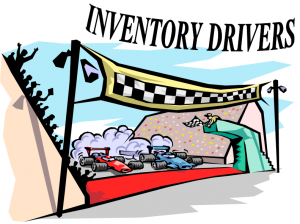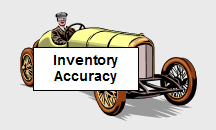 Welcome back to the ongoing series about Inventory Drivers. In this posting I would like to address Inventory Accuracy or, as is found in most companies, Inventory INaccuracy. Inventory accuracy is almost always acknowledged by everyone as critically important when being discussed but unfortunately, that importance seems to get missed when tactical decisions are made or costs are discussed. A fact of life is that it costs money to ensure a higher accuracy level. The important question to be asking yourself is: which costs more – accuracy or inaccuracy? Generally the accuracy level needs to be at least 95% or little things like MRP, locator systems and order promising systems will no longer provide accurate information which will have a direct negative effect on customer service levels, fill rates and efficiency rates. These expenses are caused by expediting, down time, missed orders, lower customer service, potential lost customers… All or which become expensive very quickly. Back in the 80’s we had a saying that “Quality is Free”. The same thought process also leads to the statement “Accuracy is Free”. Not because there is no cost but because you will spend less money achieving an accurate inventory than you will spend dealing with the problems created by inaccuracy. For anyone familiar with Lean Thinking this concept is not going to be new. If you eliminate Inventory Inaccuracy you also eliminate the waste effort and aggravation associated with Inventory Inaccuracy.
Welcome back to the ongoing series about Inventory Drivers. In this posting I would like to address Inventory Accuracy or, as is found in most companies, Inventory INaccuracy. Inventory accuracy is almost always acknowledged by everyone as critically important when being discussed but unfortunately, that importance seems to get missed when tactical decisions are made or costs are discussed. A fact of life is that it costs money to ensure a higher accuracy level. The important question to be asking yourself is: which costs more – accuracy or inaccuracy? Generally the accuracy level needs to be at least 95% or little things like MRP, locator systems and order promising systems will no longer provide accurate information which will have a direct negative effect on customer service levels, fill rates and efficiency rates. These expenses are caused by expediting, down time, missed orders, lower customer service, potential lost customers… All or which become expensive very quickly. Back in the 80’s we had a saying that “Quality is Free”. The same thought process also leads to the statement “Accuracy is Free”. Not because there is no cost but because you will spend less money achieving an accurate inventory than you will spend dealing with the problems created by inaccuracy. For anyone familiar with Lean Thinking this concept is not going to be new. If you eliminate Inventory Inaccuracy you also eliminate the waste effort and aggravation associated with Inventory Inaccuracy.
So how do you achieve an acceptable accuracy? There are many steps to that dance but some of the more important ones are:
- A Cycle Count program
- Timeliness in reporting movements
- Employee and Process discipline
- A valid locator system
- A sensible Part Numbering system
This is not a comprehensive list but they are certainly some of the most important ones to concentrate on first. I will talk more about each of these in later blogs but I would like to just touch quickly on the first two here.
While a Cycle Count program is definitely a desirable tool it will not work on its own. Without support from many other factors it will just become an exercise in frustration for everyone involved. While fixing the incorrect amounts is important, it is NOT the key to a successful cycle count program. The key is in identifying the reason for the inaccurate count and putting a fix into the appropriate process to eliminate the reason for the failure. Cumulatively, all these changes will predispose your process to having and maintain an accurate count. This allows you to decrease safety stock levels thereby reducing total inventory without increasing expediting costs. A side benefit of Cycle Counting is that you can eliminate the annual (periodic) physical inventory which is a significant cost as well as a major pain for the organization.
Regarding Timeliness – by definition your inventory count is wrong from the time you move anything until that movement is recorded in your system (paper or electronic). The longer the delay in recording the transaction, the longer your inventory system will remain inaccurate and the greater the risk it will not be entered at all or if it is entered, it will be entered incorrectly. The faster the information is recorded the less likely you are to promise something already used and less time will be spent looking for items that have been moved, shipped or consumed already. With timeliness being such a critical issue you will find that real time systems are best for dealing with this issue. With quick entry of any movements you decrease the search time for material and the amount of expediting to cover material that has been double booked. This leads to both cost reductions and to lower inventory levels and costs.
With reference to driver interaction, slow recording (timeliness) leads to inventory inaccuracy which increases the number of cycle counts required to determine why the counts are wrong. This leads to extra costs and higher inventory levels to compensate for symptoms rather than root causes. Fixing the problem rather than the symptoms is the only way to permanently improve the situation. When you throw in other drivers such as an inadequate locator system the situation gets worse quickly.
Hope this gives you something to think about and discuss with your friends and co-workers. I would love to hear back on your (and their) thoughts on this topic.

